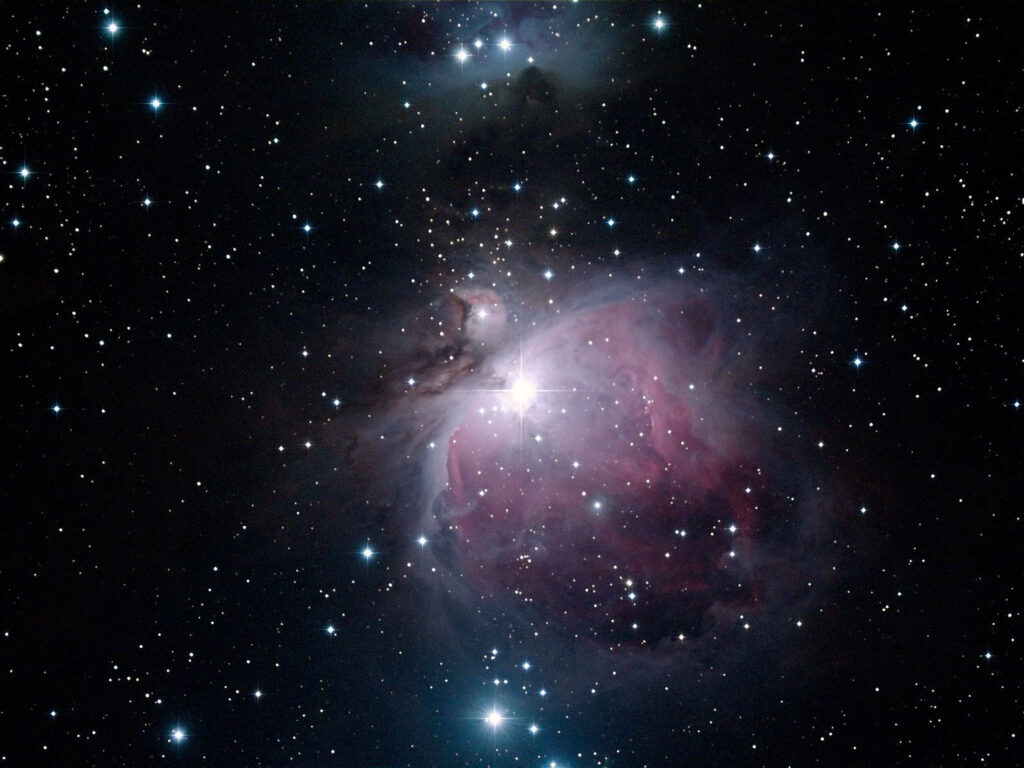The Orion Nebula is an enormous cloud of hydrogen gas spanning 25 light years (150 trillion miles) some 1,500 light years away in the Orion constellation. To put this in perspective, Voyager 1, Earth's only interstellar spacecraft, traveling at a million miles each day, would take 500,000 years to traverse its width.
The awesome beauty of this object was perhaps best described by Robert Burnham in his Celestial Handbook: "For many it creates . . . the single overpowering impression of primeval chaos, and transports the imaginative observer back to the days of creation. This irresistible impression is more than a poetic fancy, as modern astrophysics now confirms, for the Orion Nebula is undoubtedly one of the regions in space where star formation is presently underway."
The nebula is illuminated by the emission of photons as electrons that were stripped from hydrogen nuclei by absorbing energetic ultraviolet photons from young, hot stars in the interior quickly reunite with protons and cascade down to lower energy levels. The transition of electrons from the third to the second energy level produces a photon with a wavelength of 656 nanometers, which the human eye perceives as red. This phenomenon accounts for the red coloration that dominates this nebula.
As a young man, Sir William Hershel, the great 19th century English astronomer, observed the Orion Nebula through a friend's telescope. It changed his life and made astronomy a lifelong passion. Every time I view the Orion Nebula I am awed by its immensity and brilliance, and think of how a single glimpse of this object ignited Hershel's lifelong passion for astronomy. Be careful when looking at this object, for it has been known to have had a similar effect on many others!
The Orion Nebula (M42)
Date Taken:February 22, 2014
Location Taken:Siding Springs Observatory, NSW Australia
Conditions of Location: Equipment Used:Takahashi Sky90 apochromatic refractor, and an ST2000XMC camera
Processing Used:a single 5-minute color image, processed using Maxim DL and Photoshop
Distance from Location:1,500 light years
Constellation:Orion
Other Link:

Richard – As always, thank you for including me on your list for giddy recipients of your God-breathed glimpses of humbling, clarifying, reality beyond our control. In light of your ever hearty appetite for apprehending truth, it makes perfect sense that you traveled to Australia to take this shot. Most of us plain folk appear satisfied to have cellphone pics of smiling grandchildren taken in our living rooms. You opt for journeying to the other side of the earth to capture a view of a silent, seemingly inactive, more than mammoth, shimmering citizen of space which we will never physically visit and touch and smell; and which may represent a perspective that is quite outside of – or intimate with – humanity’s life and death. Are we like children searching for the fullness of the Trinity while drifting in dinghies on the surface of an unlimited sea .. which our Father made? I accept we may behold Him in His Creation; but I typically tend to choose selecting and inspecting ideas which fit in my mind and heart. Last night I took a former inmate to prison to tell his former fellow inmates what it means to be at peace in Jesus; and the congregation ( we ) hungrily embraced each word. The Orion Nebula and its shining confederates are dazzlingly beautiful and intoxicating; and as we drove home last night I was grateful that I belong in a universe of such promise and communion.
As usual, your poignant commentary is a perfect complement to the images I take. Thanks for sharing! By the way, while I took this image from a telescope located in Australia, I was operating it remotely from my office in Missouri!